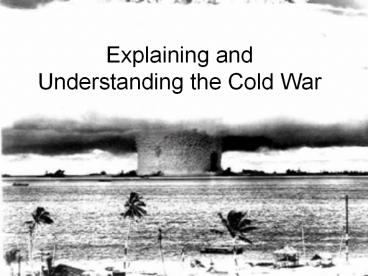Explaining and Understanding the Cold War - PowerPoint PPT Presentation
Title:
Explaining and Understanding the Cold War
Description:
Explaining and Understanding the Cold War Start of Cold War Reemergence of Communist threat Soviet Union now stronger than ever Disputes over how to reestablish rule ... – PowerPoint PPT presentation
Number of Views:95
Avg rating:3.0/5.0
Title: Explaining and Understanding the Cold War
1
Explaining and Understanding the Cold War
2
Start of Cold War
- Reemergence of Communist threat
- Soviet Union now stronger than ever
- Disputes over how to reestablish rule in Germany
and Eastern Europe - Bulgaria, Romania, Hungary, Poland become
communist - Later Czechoslovakia and East Germany as well
3
Start of Cold War continued
- Communist rule in North Korea
- Communist threats to take Turkey, Greece
- Marshall Plan provides for reconstruction to
reduce temptation of communism - Germany and Berlin left divided between victors
of WWII (democracy vs. communist)
4
(No Transcript)
5
Theoretical Strategies
- Containment form of Balance of Power
- Global Alliances NATO (1955), SEATO, etc.
- Proxy Wars in LA, Africa, and Asia
- Deterrence Strategic nuclear threats
- Nuclear Arms Race and brinksmanship
- Berlin Crisis 1961
- Cuban Missile Crisis height of tension 1962
6
Dawn of Nuclear Age
- American nuclear hegemony short-lived
- Soviets detonate first nuke in 1949
- By end of 1950s nuclear war would likely be
holocaust or Armageddon. - Massive Retaliation Strategy replaced by Mutual
Assured Destruction, which becomes default
strategy of each side.
7
Trinity Explosion at White Sands New Mexico 1945
8
Two chief approaches to constructing a nuclear
weapon
Gun Assembly U-235 (Figure by Federation of
American Scientists)
9
Attacks on Japan Gun Assembly (Little Boy,
8900lbs) Dropped on Hiroshima 60kg highly
enriched unranium
10
Implosion Device PU-239 (Figure by Federation of
American Scientists)
11
Fat Man A-Bomb dropped on Nagasaki, Japan, 1945
12
Implosion Device (Fat Man, 10,300lbs) Dropped
on Nagasaki
13
(No Transcript)
14
(No Transcript)
15
- In some sort of crude sense which no vulgarity,
no humor, no overstatement can quite extinguish,
the physicists have known sin and this is a
knowledge which they cannot lose.J. Robert
Oppenheimer
16
- The Cold War grew hotter and hotter in the 15
years leading up to the Cuban Missile Crisis. - Threat of WWIII resulted in reduced direct
tensions for rest of Cold War. - Détente of early 70s and second Reagan
administration saw improved relations, especially
during the latter. - Arms control and reductions began in 1960s and
continued in various ways into 1990s.
17
Causes of the Cold War 3 views
- Traditionalist -- Evil Soviets caused it and were
bent on world domination. - Communist expansion in Eastern Europe and Asia
seemed to support this view. - Revisionist -- USA caused it by over-reacting to
reasonable USSR security measures. USA and USSR
misperceived each others intentions, but US
reaction more provocative. - USA and other states had tried to undermine
Soviets during Russian Revolution. Capitalist
states wished to stomp out atheistic communists.
NATO and other alliances used to Contain USSR.
18
Causes continued
- Post-revisionists -- These folks see the Cold War
as close to inevitable considering power vacuum
left after WWII and the ideological threat posed
to each superpower. Cold War was return to a
balance of power system that was now more a
balance of terror system because of nuclear
threat. - Both ideology and system structure play a role.
19
Why didnt the Cold War turn hot?
- Neo-Realists say bipolar world made balancing and
alliance more successful. Little chance of
defection or shifting alliances. - Others claim fear of nuclear war was more
sobering than threat of past wars. Ideological
fear and hatred more than enough cause to fight
war if it wouldnt meant end of humanity.
20
Explanations for End of Cold War
- Republican Revisionists Reagan beat them in
arms race. - Over-expansion of USSR? (domestic)
- Economic collapse (domestic)
- Power of ideas (or lack of) Crumbling of
ideology in USSR (constructivist) - Gorbachev threw in towel individual level
- Neither Realism or Liberalism did a good job
predicting end of Cold War.































